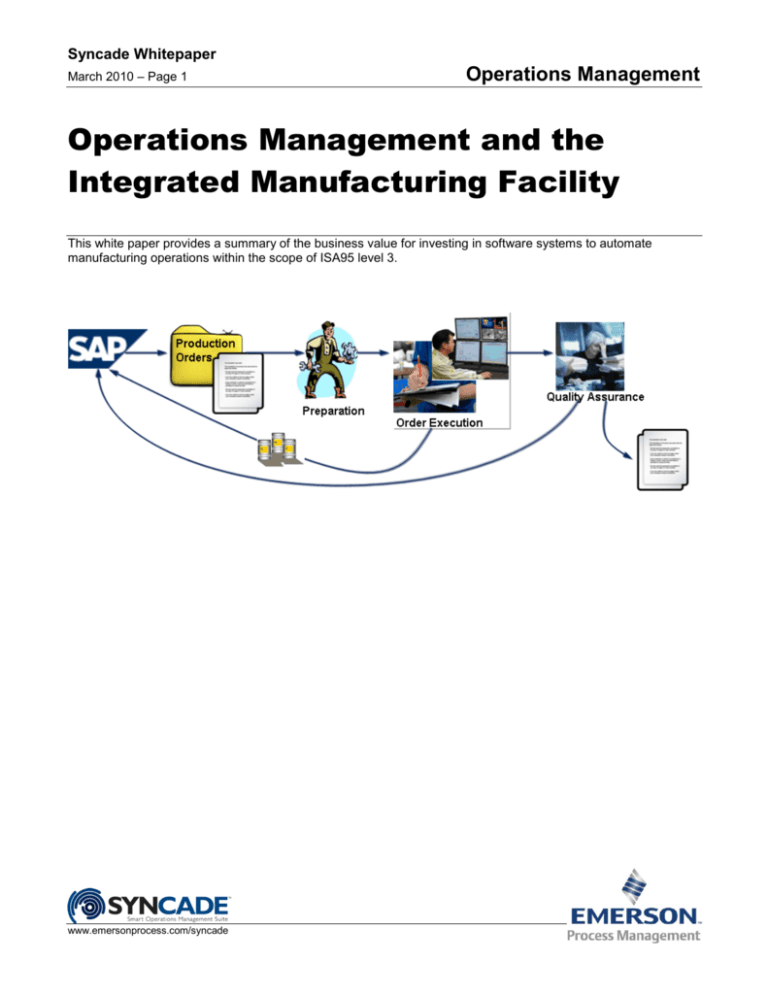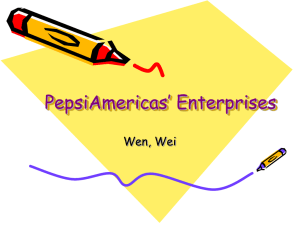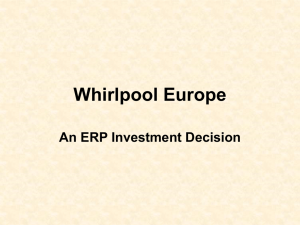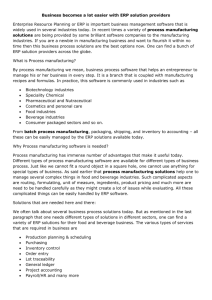
Syncade Whitepaper
March 2010 – Page 1
Operations Management
Operations Management and the
Integrated Manufacturing Facility
This white paper provides a summary of the business value for investing in software systems to automate
manufacturing operations within the scope of ISA95 level 3.
www.emersonprocess.com/syncade
Syncade Whitepaper
March 2010 – Page 2
Operations Management
Table of Contents
Introduction.............................................................................................................................. 3
Going Beyond Process Control to Gain Manufacturing Operations Efficiency ................. 3
Inefficiency of Paper Operations ............................................................................................ 5
ISA95, a Framework for Integrated Operations ..................................................................... 6
Why Invest in Electronic Operations Management? ............................................................ 8
ERP to Plant Floor Integration................................................................................................ 9
Production Management ......................................................................................................... 9
Material Operations ............................................................................................................... 10
Conclusion ............................................................................................................................. 11
Syncade Whitepaper
March 2010 – Page 3
Operations Management
Introduction
Emerson has extended it award winning PlantWeb digital architecture to include manufacturing operations
management capabilities with its Syncade Smart Operations Management Suite. The purpose of this white paper
is to describe the need, application, and value of using IT software solutions to manage production, material, and
quality operations and the value of integrating process control and IT systems to improve manufacturing agility,
efficiency and right first time performance.
Through the application of IT systems that bridge between the ERP and the process control system, operations
can be improved that result in improved capacity utilization, lower cost of manufacturing, reduced inventory, and
lower cost of quality.
Going Beyond Process Control to Gain Manufacturing Operations
Efficiency
In today’s market, process manufacturers are experiencing relentless pressure to improve operations. The
challenges being experienced include globalization that are forcing facilities in developed economies to compete
with capacity from developing economies. Customers continue to increase expectations for quality and on time
delivery. As the workforce ages and retires, experience is lost, and government regulation from OSHA, FDA,
EPA, and others seems to bring an ever increasing burden for compliance.
These challenges have process manufacturers looking for ways to increase efficiency and improve manufacturing
performance. In order to take the next step in process manufacturing efficiency it will be necessary to go beyond
the basics of good process control. World class process manufacturers are now investing in IT systems for
manufacturing operations management to address the entire supply chain requirements including productions,
material, and quality operations.
In the figure below, the production process is illustrated from planning to shipment. The ERP is the production
and resource planning domain. This is the front end of the process that turns customer demand into production.
The output of production planning are production orders (1). Production orders typically includes:
Intermediate and finished goods products to be made
When to make the products
How much to make
Equipment and materials that should be used
Procedures to follow to make the products
Quality specifications
There may be many different production orders that need to be prepared including intermediates as well as the
final product.
Syncade Whitepaper
March 2010 – Page 4
Operations Management
Figure 1 Process Production from Planning Shipments
After the production orders are created, in many cases there is preparation to be completed prior to executing the
order (2). Equipment may need to be reconfigured or cleaned. Materials may need to be staged such as a change
in catalyst or addition of additives; equipment integrity may need to be verified such as pressure checks,
calibration checks and filter expirations; or it may be necessary to verify training records of the people assigned to
do the work if you are in a regulated industry.
After the preparations is complete, the order can now be executed. When executing an order, many things need
to be done and coordinated. The process control system (4) needs to be put in the correct mode of operations
with the correct operating parameters, automated sequences may be required to be executed from the control
systems, manual procedures (3) need to be performed such as charging materials, material calculations, or
manually opening values that are not automated. Operator rounds may be required to collect process information,
in regulated industries, signatures may be required. Samples (5) need to be taken and delivered to the lab, lab
results (6) have to come back to the plant floor for use in calculations, processing decisions, and quality
documentation. If these plant floor activities are not properly coordinated and correctly performed a significant
impact to quality, yield, productivity, or safety could be experienced.
Once process manufacturing is completed, the material flow may need to go through packaging and finally
material accounting needs to be performed so that the ERP inventory is updated to reflect raw material
consumption, and the creation of finished goods (7).
Before production can be released for shipment, Quality Assurance need to gather all the relevant quality and
production records and review all critical process parameters to verify they are within the required specifications
(8). Information may be incomplete and QA may need to go back to manufacturing and the lab to get the required
information. This process can take from days, weeks, and in rare cases months to complete. All the while,
material is waiting in an unreleased status and cannot be shipped. When QA approval is completed, the
production is released and approved for shipment (9).
Syncade Whitepaper
Operations Management
March 2010 – Page 5
The operations described above are operations that are not typically automated with instrumented equipment but
rather depend upon people to execute by following procedures and recording the results of the procedures in
documentation. Significant opportunities to increase manufacturing performance may be obtained to transitioning
these operations from paper driven activities to software system driven transactions.
Inefficiency of Paper Operations
Controls for the execution of manual procedures have been traditionally performed with the definition of the work
process being contained in Standard Operating Procedure (SOP) documents and the performance of these
operations recorded on paper forms as part of the production record. Managing production, quality, material, and
maintenance operations with paper procedures and manually created production records limits manufacturing
efficiency for the following reasons:
Table 1 Paper Inefficiency Vs. Business Impact
Paper Inefficiency
Business Impact
Coordination of people and information
Reduce productivity, cause delays
Execution of paper based procedures
Operator error impacts quality, capacity utilization and
productivity
Paper documentation of production data
Error prone, loss of productivity, typically needs to be
transcribed between systems, results in inaccurate recording
of production information
Paper based material accounting with post
production entry into ERP Inventory System
Inaccurate inventory results from latent data entry and data
entry errors; can result in either excess inventory or
inventory shortages
Transcribing information between computerized
systems and paper documentation
Error prone, lost productivity
Paper based tracking of production status
Limited visibility of production status results in lower
productivity since time is consumed creating shift reports to
keep everyone updated and less efficient production
planning can impact capacity utilization
Paper based production tracking can result in poor
coordination of the production process
Production delays reduce capacity utilization
Paper based maintenance management
Delays in work order execution, inability to implement
predictive maintenance
Asset performance information is collected in
paper log books
High maintenance costs resulting form the inability to
analyze asset performance
Paper based quality management slows
production release for shipment
Excess inventory is needed to meet customer shipments
Personnel qualification management
Productivity, compliance, and quality
Material usage on the plant floor is documented on
paper
Post production entry of material use into ERP is error prone
and adds latency to accurate inventory management
Actual time to perform process operations is
difficult to document
Use of “standard labor” hours for labor accounting results in
inaccurate understanding of labor costs.
Syncade Whitepaper
Operations Management
March 2010 – Page 6
ISA95, a Framework for Integrated Operations
World class process manufacturing companies are transforming from inefficient paper based operations
management to highly efficient, coordinated, integrated, computer based production, materials, and quality
management. This transformation is enabled by investing in Operations Management systems and integrating
these systems with the other strategic manufacturing systems. ISA95 (www.isa-5.com/subpages/technology/isa95.php) defines a systems architecture standard to provide guidance for the implementation of a digital
manufacturing by implementing integrated software systems to eliminate paper based processes. This standard
defines manufacturing systems level 0 to level 4. Figure 2 provides a brief summary of the ISA95 manufacturing
systems model and the typical type of system available for each level. Level 0 references the process, level 1
references instrumentation, level 2 references control and supervision, and level 4 references the business
planning and logistics. Level 3 is defined for Manufacturing Operations Management and represents the least
automated area of the ISA95 model and is managed by paper in many process facilities.
Figure 2 ISA95 Model and Systems Reference
Process manufacturers have for the most part invested in electronic systems for process measurement, control,
supervision, and the enterprise resource planning functions. Investing in electronic systems for level 3,
manufacturing operations management, has been lagging largely due to the fact that the systems available for
meeting the Operations Management functions have required a large degree of customization and have been
costly to implement and own. This has now changed with the availability of cost effective, configurable, web
based, standard product solutions for Operations Management. Emerson’s product for operations management
is Syncade Smart Operations Management Suite. (www.emersonprocess.com/syncade)
Syncade Whitepaper
March 2010 – Page 7
Operations Management
The process industries are now a transforming from paper based to electronically executed manufacturing
operations in order to increase production efficiency and quality. Configurable solutions are now available to
manage process plant production, quality and maintenance activities. Syncade Smart Operations Management
Suite provides software to manage process manufacturing operations and functions complimentary to the process
control layers (ISA95 levels 1&2), providing solutions for material tracking, order management, manufacturing
procedure workflow, systems integration and data visualization, and document management.
Figure 3 Syncade Smart Operations Management Suite Applications
In addition, the changes to the economics of operations management software, the advent of wireless plant
network solutions have also made implementation more practical. Many operations are performed by workers
who are in the plant at the process unit. The mobile nature of this work has made the use of a paper on a clip
board the traditional medium for controlling the execution and documentation of plant floor operations. Emerson
now offers Wireless Plant Networks (see www.emersonprocess.com/smartwireless) that enable workers who are
mobile within the process plant to perform and document work procedures interactively with a wireless terminal.
Figure 4 Emerson Wireless Mobile Worker Device
Syncade Whitepaper
March 2010 – Page 8
Operations Management
The wireless mobile worker terminal is well suited for industrial environments and is available with a class 1 Div II
electrical classification and can include bar code scanners for use with the Operations Management software.
Why Invest in Electronic Operations Management?
Potential areas of value realized from investing in operations management systems are listed in table 1. Reduced
operator errors are realized through electronic guidance in the performance of manufacturing procedures as well
as reductions in manual data entry and operator calculations. Better production coordination occurs through the
integration of ERP, lab, plant floor automation, manual procedures, documentation and maintenance systems.
Better quality can expected from reducing errors and the cost of quality is reduced from fewer deviation
investigations and exception reporting. Because quality is improved, and less errors are made, faster quality
assurance review and approval can be expected.
Better right first time rates increase productivity and reduce waste and rework. Higher capacity utilization is
realized through increased visibility to the plant floor and improved cycle times. Working capital requirements are
reduced because of increased accuracy in material accounting, reduced inventory requirements, shorter product
release times, and automated transactions for raw material consumption and finished good creation.
Finally, plants can expect improved compliance and better plant wide visibility to production status.
The following summarizes the benefits of electronic manufacturing operations management:
Reduced Operator Errors
Better Production Coordination
Better Inventory Management
Faster Cycle Times
Increased Productivity
Higher Capacity Utilization
Reduced Working Capital
Improved Right First Time Rates
Less Waste And Rework
Better Quality, Lower Cost of Quality
Improved Compliance
Syncade Whitepaper
Operations Management
March 2010 – Page 9
ERP to Plant Floor Integration
Many organizations are putting effort into integrating the plant floor with their ERP systems. The reason for this is
that it enables efficient coordination of the manufacturing capacity with the production demand. Integration
between the ERP and plant floor enables agile manufacturing responses to quickly and efficiently change the
production on the plant floor to meet the needs of the business. ERP to Plant floor integration enables a variety of
capability including:
Table 2 Capability vs Business value for ERP to Plant Floor Integration
Capability
Business Value
Automatically driving a production order from
the planning domain into the manufacturing
domain
Faster response to business demands, better control
over finished goods inventory
Automatic changes to plant floor equipment
operation including cleaning, setup, and
operating conditions needed to produce the
planned production lot
Better capacity utilization, faster change over to new
operating conditions, less off spec production
Planning and scheduling capability has real
time updates on the production status for
production lots in progress
Improves planning, production release, and capacity
utilization
Real time and automatic updates for ERP
inventory based on plant floor material usage
More accurate inventory management results in
better use of working capital
Plant floor integration enables uploading of
actual start and finish times for processing
steps into the ERP
Enables labor accounting to be based on actual labor
rather than standard labor hours
ERP data entry is automated from the plant
floor systems
Improves productivity by eliminating post production
transcribing of data from paper records into the ERP
and eliminates data entry errors
Production Management
The ERP is where supply chain planning determines how the production capacity needs to be applied to meet
customer demand. Its Syncade’s role to enable the production capacity to quickly and efficiently respond to
changes in product demand or feed stocks.
The ERP issues a production order and is received by Syncade which provides plant floor order management.
The Syncade order contains all information needed to make the product. The Syncade order can initiate and
coordinate any required changes to the control system such as initiating startup sequences, operating condition
changes, or starting batches. If there are any manual procedures that need to be coordinated with the automated
procedures, Syncade will create the workflows that guide the operator through the performance of the manual
tasks and keep these coordinated with the rest of the operations.
Wireless mobile worker terminals may be used to perform the workflow driven manual procedures. Syncade
assures operations are performed completely, accurately, and right first time. When production operations are
complete, the production record can automatically be generated, routed for approval and archiving.
Syncade Whitepaper
March 2010 – Page 10
Operations Management
Using Syncade to manage production operations provides increased agility by enabling faster transitions from
planning to order execution. Whether it’s a product grade change, changing batch production, or changing to
feed stocks, faster coordination of change over activities increases capacity utilization.
Syncade Suite makes the production operations more efficient by eliminating the paperwork needed to create and
track production orders, eliminating the time and effort needed to type operating parameters from the production
orders into the control system, and eliminating the work needed to write process information into production
records.
Right first time benefits can provide enormous value. Syncade Suite increases right first time performance with
workflows that enforce the performance of procedures, the collection of data and signatures and eliminate data
entry errors.
Figure 5 Syncade Application for Production Operations
Material Operations
In many process facilities raw materials may be allocated by the ERP, but are tracked by hand written documents
on the plant floor and sometime after production is completed consumed materials are transcribed from the hand
written production records into the inventory management system to update the inventory to reflect the materials
used. This process has several problems. First, there is significant latency between when materials are used
and when they are entered into the inventory system, second, manually transcribing material usage from hand
written records into the inventory management system can result in data entry errors. These two factors can
result in inaccurate inventory, resulting in either excess inventory or inventory shortages. Another problem with
this is the lost productivity resulting in having resources having to record material usages by hand, and then later
type them into the inventory system.
Syncade Whitepaper
March 2010 – Page 11
Operations Management
The integrated process plant provides a better way to track material usage. The ERP creates a production order
and allocated material to the order. At this point, the order including the materials are handed off to the plant floor
order execution system where materials can be weighed, if needed, then at the point in the process they are
charged to the process bar code scanning can be used to verify the correct materials are being used, the plant
floor system documents the materials and issues a transaction to the ERP to automatically show the material
consumed at the point in time they are used.
Figure 6 Real Time Plant Floor Material Tracking
Conclusion
Process manufacturing facilities that are looking for ways to improve efficiency and productivity, lower costs, and
increase capacity utilization should assess the use of automated operations management software system to
manage production, quality, and maintenance operations. The use of integrated software systems to perform
these capabilities is proven to stream line operations through the coordination of people, materials, equipment,
and procedures involved in manufacturing. Elimination of paper based process eliminates errors and speeds
production and quality management activities.
Emerson’s PlantWeb architecture has been extended to include Syncade Smart Operations Management Suite
providing capabilities for production operations, material operations, and quality operations.
Syncade Whitepaper
March 2010 – Page 12
Operations Management
Evaluating investment in software systems for operations management should begin with establishing business
objectives and then developing a business case for investment. Emerson consultants can help with overall
investment assessments and business case development.
Contact Emerson at Syncade@emerson.com for more information on how Emerson can help you develop a
strategy to stream line process manufacturing.
To locate a sales office near you, visit our website at:
www.EmersonProcess.com/Syncade
Or call us at:
Asia Pacific: 65.777.8211
Europe, Middle East: 41.41.768.6111
North America, Latin America:
+1 800.833.8314 or
+1 512.832.3774
For large power, water, and wastewater applications
contact Power and Water Solutions at:
www.EmersonProcess-powerwater.com
Or call us at:
Asia Pacific: 65.777.8211
Europe, Middle East, Africa: 48.22.630.2443
North America, Latin America: +1 412.963.4000
© Emerson Process Management 2009. All rights reserved. For Emerson Process Management trademarks and service marks, go to:
http://www.emersonprocess.com/home/news/resources/marks.pdf.
The contents of this publication are presented for informational purposes only, and while every effort has been made to ensure their accuracy, they are not to be
construed as warrantees or guarantees, express or implied, regarding the products or services described herein or their use or applicability. All sales are governed
by our terms and conditions, which are available on request. We reserve the right to modify or improve the design or specification of such products at any time
without notice.
www.emersonprocess.com/syncade








